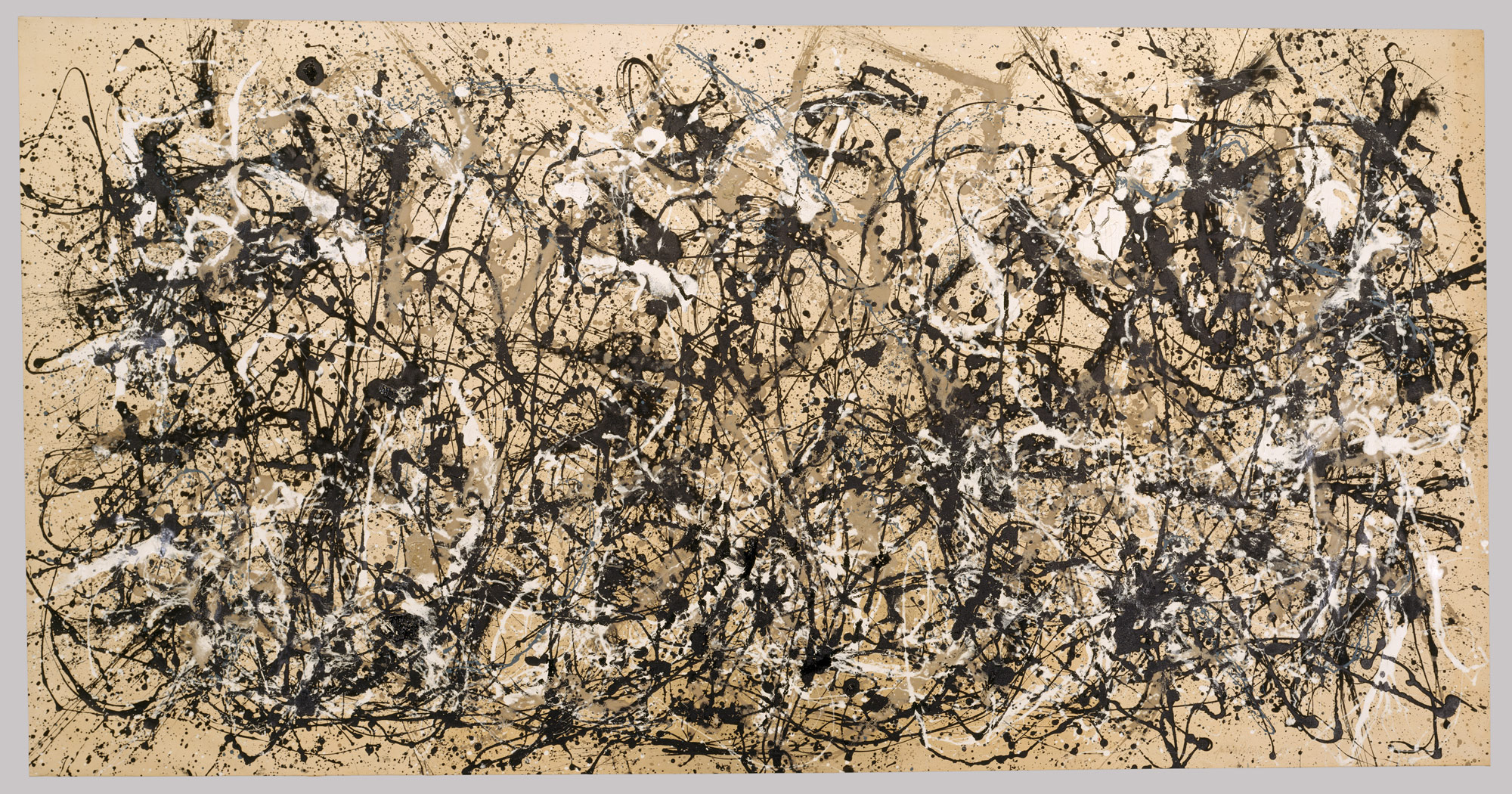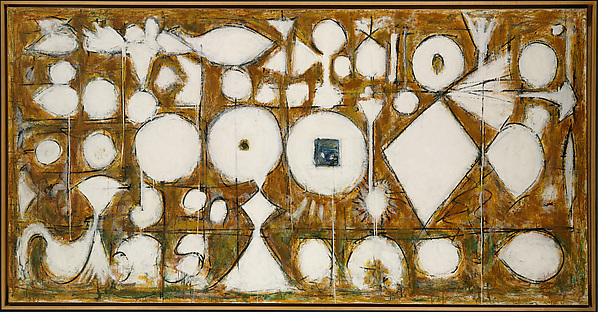There are groups, and there are
individuals. Then, there are groups of
individuals. Finally, there are individuals
who stand alone in a group of individuals.
These icons are known as individual[ists]. And it is to the [ists] part of these [individuals]
that our attention is turned to today.
As the work of Richard Pousette-Dart demands an undivided focus for the
work of such a singular artist.
Born
into the arena of Abstract Expressionism—that is, the spiritual as expressed
through an abstract subconscious—these post WWI oddballs thrived from the
wellspring of post-war animosity, with Pousette-Dart fitting in well. Yet at the same time, not well at all. An oddball in the mix of oddballs—an ugly
goose in a culture of ugly ducklings—Pousette-Dart’s strictly individual style
was what made a name for himself. A theft
painter, Pousette-Dart’s pulling of his here-and-there influences to form a
style of irreverence made him stand apart from fellow Expressionists whose
painting was strictly colloquial.
Nevertheless,
it is all too easy in the modern culture of heightened individualism and
self-interest to catch oneself mid-praise for the narcissism of an artist.
And
this is true with Pousette-Dart’s work.
Yet however self-aggrandizing the work may be in terms of the searching
of the self for truth—self-interest is by no means the only truth he offers the
viewer. For however agreeable the
Abstract Expressionist movement was to Pousette-Dart, Pousette-Dart stood out
not only as iconoclast, but also as a leading forefather of the Abstract
Expressionist movement.
For
while it is made clear to us viewers that Pousette-Dart’s work stands on its
own as representation of the fortuitous triumph found in the realm of
individual expression, Pousette-Dart never strays far from his roots in cubism,
primitivism and Abstract Expressionism. So
it is to this examination of relationship this curatorial is dedicated. That is, the unraveling of the relationships
between influence, ideation and individual, as witnessed in the work of Richard
Pousette-Dart.
East River, Richard Pousette-Dart, 1939, Oil on Masonite, 2005.483
Cubism
plays a heavy influence in this piece.
Pousette-Dart has admitted to Picasso’s influence on his work, which is
especially prevalent in this still vulnerable stage of Pousette-Dart’s early
work. This piece is a landmark to
Picasso’s influence. Seen specifically
with the distortions of shapes and images familiar to the eye—the piece also
reminisces one of Picasso with the dark subject matter, and dismal coloring. Yet however dedicated the piece may seem to
Picasso’s Cubism, more influences lie under the surface of East River. Primarily, primitivism. Which, simply put, is an older form of
spiritual art which harkens the mind to subconscious truths as embedded in the
innate. In East River, this is witnessed
in tribal like symbolism, strange disturbing shapes and abstracted landscapes.
Autumn Rhythm (Number 30), Jackson
Pollock, 1950, Enamel on Canvas, 57.92
Probably
the most famous of the Abstract Expressionists for his uncontrolled style and
irrational lifestyle, Jackson Pollock led the Abstract Expressionists with
lesser-known Pousette-Dart by his side. Autumn
Rhythm is extraordinary. For the
heightened moment of self-expression is captured upon this canvas in all of its
messy glory. Yet whatever fame or
recognition Pollock received are pale in comparison to Pousette-Dart’s
paintings. For even Pollock’s most
imaginative and well-known creation wither under the influence and
individuality of any of Pousette-Dart’s work.
For, as witnessed in Autumn Rhythm, Pollock is no match for
Pousette-Dart’s higher expression formed from more educated influences, though
the piece is a higher form of expression in itself.
Seasons of Light, Richard
Pousette-Dart, 1942, Gouache, Watercolor, Ink on Paper, 1991.476.2
Seasons
of light, for example, may trump all other Abstract Expressionist paintings as
the most dense, and full of subconscious meanings. Pousette-Dart really lets himself go here, as
he enters into the darkest recesses of his mind to find out what innate truths
live there. This is a painting upon the
horrors of war. Yet not with traditional
signs of war, such as screaming children or bloodied soldiers. Rather, Pousette-Dart focuses on what effects
violence has upon the tender subconscious of the mind, representing the terrors
within with bright colors, swirling images, splattered paint, and in general, a
fecundity of color and symbolism.
Pulling together his influence in primitivism and Picasso to boost his
own blatant self-expression, this piece boosts a step forward in
Pousette-Dart’s individual style.
Lois Long, Richard Pousette-Dart,
1953, Gelating Silver Print (Photograph), 1996.169
Yet
soon Pousette-Dart returns to a darker expression. One could say this is reminiscent of Picasso
again with its darker themes and dreary lighting. But I think what we find here is Pousette-Dart
exploring a new medium of expression with the same goal of intent. No longer subject to primitivism or
distortions, this painting is alternatively freed, in a sense, by it’s simple,
yet weighty statements. Though we cannot
know for certain what these statements are, we draw from our knowledge of the
author. The picture assembles the pieces
for us, in a dismal scene centered on a lonely woman, a depressed cat, an eerie
photograph and a hopeful glimmer from outside sunlight. It seems as though Poussette-Dart were using
this new medium as a break to figuratively paint a portrait as to what our
deepest and most abstract desires are.
Let the pieces here fall into places of understanding.
Path of the Hero, Richard
Pousette-Dart, 1950, Acrylic on Canvas, 1987.3
Pousette-Dart
returns to his influences here, but not as urgently as in his younger
paintings. For in the Path of the Hero
the painter has found the middle ground between using Primitivism and Cubism to
form his own, unique style of expression. For example, look at the circles. Or are they spheres? We are witnessing the real life separation
from influence to identity here.
Secondly, the odd shapes, and geometry recollects again to primitivism
influence, yet is restrained here as Pousette-Dart twists it for his own,
individual, understanding and expression of the subconscious mind.
- Holton Winburne





No comments:
Post a Comment